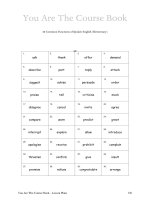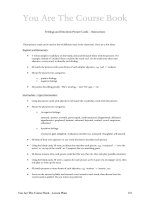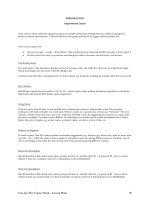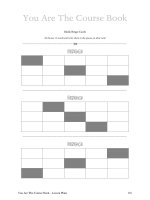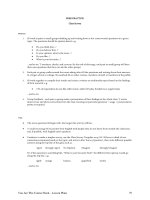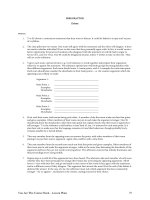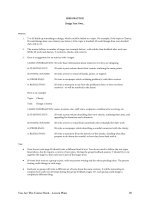yatcb lesson plans topic template
Bạn đang xem bản rút gọn của tài liệu. Xem và tải ngay bản đầy đủ của tài liệu tại đây (59.53 KB, 2 trang )
FREE PRACTICE
Topic Template
Method:
1.
2.
T or SS choose a situation based on a topic, for example:
Topic:
Situation:
Cars
Selling a car
The Human Body
Having plastic surgery
Christmas
Choosing Christmas presents
T elicits various elements for each situation to create a table. Note: at this stage, it is important that each SS in
the class has the same table.
Example #1: Selling a car:
Make
Model
Price
Year
Colour
Mileage
Jeep
Nissan
Hyundai
etc.
Selling
Points
Drawbacks
Outcome
etc.
Result
etc.
Example #2: Having plastic surgery:
Person
Pippa
James
Jane
etc.
Part to
Change
Reason
Price
Procedure
What Friends & Family Think
Example #3: Choosing Christmas presents:
Recipient
Age
Relationship
Present
Mum
Dad
Lucy
etc.
Price
Store
How Long
Wanted
Reason
Outcome
etc.
3.
SS work in pairs to complete information in the table. T monitors, checks, and corrects. SS are free to use
as much imagination as they possess!
4.
SS find a different partner and sit back to back with them. One SS talks about their situation as if it has
happened to them or to somebody they know, using the information they have written. The other partner
listens, asks questions, and makes notes. For example, in the ‘selling a car’ activity:
Student A:
Student B:
Student A:
I’m selling my Jeep.
What year is it?
2010.
You Are The Course Book – Lesson Plans
93
...and so on.
T reminds SS that they should use full sentences, rather than simply listing what is in each box of their
grid. Then the second SS talks about their situation – again, as if it has happened to them – while the other
listens, asks questions, and makes notes.
5.
Or, this activity could be done as a straightforward information exchange: SS fill in the table separately,
then ask each other questions to find out the information in their partner’s table. For example, in the
‘plastic surgery’ activity, above, SS could ask:
Student A:
What procedure is Pippa having?
Student B:
Botox.
Student B:
What is the reason for Jane’s procedure?
Student A:
She’s unhappy with her nose.
...and so on.
SS could note down the questions they had to ask to get each piece of information.
6.
Group feedback: T asks some or all of the pairs to present their work – or extracts from it – for the whole
class. T writes down errors and elicits corrections and improvements from the class.
Tips:
•
The more entries in the vertical column on the left, the longer the activity will last. For a short activity, SS
should work with only one entry, e.g. one car, in the first example, above.
•
The success of this activity will be determined by the quality of the situation that T and/or SS choose
initially. Primarily, it should be something that is of interest to and relevant to the SS.
•
SS could develop their ideas into:
o
o
o
o
•
role plays
dialogues
‘gossip’ monologues (see p.83)
short stories (for homework)
See also You Are The Course Book 2: In Practice 1, pp.316-317.
Purland, Matt. You Are The Course Book 2: In Practice. Ostróda: English Banana.com, 2013. Hardback. Available for free download:
/>
1
You Are The Course Book – Lesson Plans
94
